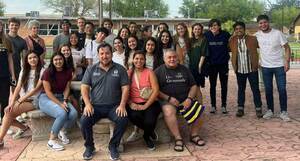 "
"
I never would have imagined that a handful of kids from the other side of the world would be so formative to the apprehension of my own outlook on life. During fall break, I had the opportunity to travel to the border between Mexico and Texas with 11 other members of Notre Dame’s Transformational Leaders Program to immerse ourselves in the immigration crisis. Our time was split between serving the immigrants residing at the Catholic Charities Respite Center, hearing stories from those who spend their lives working with immigrants, reflecting as a group and simply enjoying each other’s company.
Before this trip, I couldn’t fathom what to expect, or anticipate if I would change in any way by the end of this trip. If I’m being honest, I still ponder how this trip has changed me. My perspective has shifted, but as I look back on my experience, I find myself digesting it in a new light every time. I don’t want to sit here and write about some dramatic theme or conclusion that you should hold toward the immigration situation. Mainly because I don’t have one, and if I did, it would do no good to tell it to you. All I can do is tell you a bit about my experience at the border.
When we first arrived at the Catholic Charities Respite Center, it didn’t look anything like the image I had in mind. The building had three main rooms and a small security airlock you needed to enter through, all fitted with massive bulletproof, blacked-out windows. There was a kitchen and dining room, a room dedicated to sleeping and a main room for gatherings. The main room was a giant box with very bright lights, loud noises and chairs everywhere. I would be lying if I said that I wasn’t overwhelmed my first time entering that room. Although, it didn’t take long for that feeling to dissipate — about 30 seconds after entering, we were already up to our necks playing games with kids, serving food and distributing clothes, along with countless other tasks that needed to be fulfilled.
What struck me the most, however, was how roughly 60% to 70% of those residing in the building were children, most of whom looked to be younger than 10 years old. It didn’t line up with my previously held image of what an immigrant center would look like. Another thing that perplexed me was what each child had to go through to get to that center compared to my own travels. We both ended up in the same place, yet my comfortable flight to Texas was a complete juxtaposition to the journey those children had to make through South and Central America. I was able to learn the stories of some of the children and what they had to go through. One girl, who must have been under five, traveled with her abusive mom on foot all the way from Venezuela, having to deal with both physical and mental pain inflicted upon her throughout her journey. Another older boy told a friend of mine that he lost his father along the trip and hadn’t heard anything about his whereabouts or if he was even alive. These kids weren’t the only ones going through hardships, as our group heard hundreds of stories of those who didn’t survive the journey to the Center and many who did just to be sent back to the country they came from, being killed shortly after. For every story a child told of making it to our country, there was always another of someone who died trying.
What is inspiring, though, is how those same kids who went through all those hardships weren’t depressed at all. They all had hope. They laughed and played, never feeling sorry for themselves or upset over what they had to go through. Seeing all those kids and the energy they possessed was invigorating. It made me question the way I look at life and if my outlook has been wrong, or at least mostly incorrect, on what it means to live a meaningful life. While my conclusion on what I saw might be different from others, I hope that introducing honest stories from the border invites an opportunity for a greater audience to question the way they view the world.